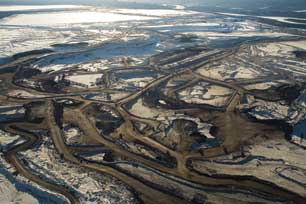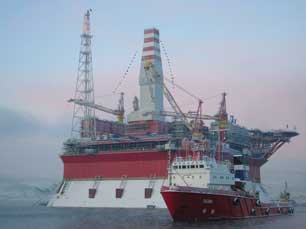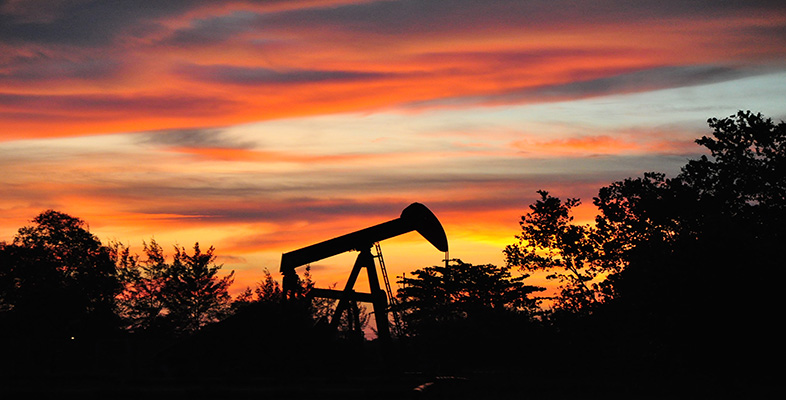6.2 Non-conventional oil
It is generally agreed that there are huge quantities of non-conventional oil still to be extracted, and the quantities are estimated to be greater in total than those of the unextracted conventional oil remaining. However, by definition the non-conventional oil is much harder to get out of the ground and to process. The two types of non-conventional oil most often discussed are oil sands and heavy oils, and you will briefly explore issues related to these. You will also look at three other types of oil that might be classed as non-conventional: deep-water oil, polar oil and natural gas liquids.
Oil sands

Oil sands (also known as tar sands) are formed when oil flows into near-surface sands from deeper underground reservoirs. Exposure of crude oil to air and bacteria close to the surface degrades the oil into thick, viscous bitumen, with the consistency of very thick treacle. The fact that the bitumen is mixed with sands, clays and water - together with its extreme viscosity - makes it difficult and expensive to extract the oil. Until very recently, oil sands have been collected by large-scale strip mining (Figure 10), which involves scooping up vast quantities of the sands using huge machines. The enormous volumes of oil sands are then heated to around 80 °C to separate and chemically change the bitumen to produce a material that flows more easily and has a chemical make-up more similar to that of conventional crude oil. This is a complex, energy-intensive and expensive process, but in recent years, as the price of oil has increased, it has become an increasingly competitive alternative to conventional oil sources.
Where oil sands lie too far beneath the surface to allow surface mining, huge volumes of steam or hot carbon dioxide gas are injected deep below ground; after several months, the viscosity of the oil is lowered enough to allow the oil to be pumped to the surface.
The world's largest producer of crude from oil sands is Canada, where the Athabasca area of northern Alberta has reserves of oil second only to those of Saudi Arabia. It takes two tonnes of oil sands to produce one barrel of oil.
What percentage by mass of oil sand is recovered as crude oil, and what does this tell you about the amount of waste generated by this process?
One barrel of oil has a mass of approximately 0.14 tonnes, so two tonnes of oil sand might produce approximately 0.14 tonnes oil.
So percentage of oil recovered = (0.14 tonnes/2 tonnes) × 100% = 7%
This implies that a staggering 93% of the oil sand is discarded as waste.
The oil from oil sands has been described as the dirtiest oil on Earth. The huge-scale strip mining destroys habitats (Figure 10). The processing creates huge quantities of toxic residues. It takes three to five times more energy to extract crude oil from oil sands than it takes to extract conventional oil. According to one estimate, this means that burning a litre of petrol from oil sands results in 20% more greenhouse gas emissions than burning a litre from conventional sources.
Heavy oils
Heavy oils are highly viscous deposits of crude oil which will not flow to the surface under their own natural pressure. The largest resources are the Orinoco heavy oils of Venezuela, which represent almost 90% of the known reserves of this form of crude oil. Like oil sands they have to be specially treated before they can be used in conventional oil refineries. Heavy oils tend to have a composition that makes them less economic to process once they have been extracted: for instance, they contain relatively high levels of sulfur and heavy metals, which have to be removed before normal processing.
Heavy oils suffer many of the same environmental problems as oil sands. The extraction is very energy-intensive, resulting in higher greenhouse gas emissions than those for conventional oil, and the presence of contaminants can lead to large volumes of toxic wastes.
Deep-water oil
As the price of oil has climbed, companies have found it profitable to explore for and extract oil from less accessible places. In the context of undersea oilfields, this has led to a trend towards the exploitation of resources found in increasingly deeper water. For environmentalists, the dangers of this trend were exposed by the Deepwater Horizon oil spill in April 2010. The pressure control systems of the oil well failed, leading to a huge underwater blowout. The explosion killed 11 workers on the drilling rig and an estimated 2.9 million barrels of oil flowed into the waters of the Gulf of Mexico. The full ecological consequences of the spill have, at the time of writing (2011), yet to be determined.
Polar oil
The Arctic is seen by many as an unspoiled wilderness that should be protected - iconic images of polar bears trapped on melting ice floes have often been used to dramatise the effects of anthropogenic global warming. But many of the states bordering on the Arctic view the region in quite a different way - they see it as a potential source of valuable oil and minerals. The Arctic is estimated to hold 13% of the world's resources of oil (and 30% of its gas). The US Geological Survey has suggested that it is the largest unexploited source of conventional oil in the world.

Drilling for oil in the Arctic poses a number of problems: the extremely low temperatures, the perpetual night in winter, shifting pack ice, icebergs and storms. So far, oil companies have concentrated their efforts around the more accessible fringes of the Arctic. The next phase of oil recovery is likely to focus on sheltered shallow-water regions close to shore. However, plans are well under way to start exploring for oil in the less accessible parts of the area. In order to drill in deeper water, vast steel platforms are being built, such as the Russian Prirazlomnaya platform (Figure 11). The huge bulk of such platforms will stop them from being crushed by the shifting pack ice that covers the sea for eight months of the year. However, these platforms will not be suitable for drilling in really deep Arctic water where it's likely that ice-resistant ships will float on the surface collecting oil from underwater wells below.
Plans to rapidly develop Arctic oil resources have enraged environmental activists, who question the safety of deep-water drilling - especially in the light of the Deepwater Horizon incident. Others argue that the real risk will not be from the wells themselves but from the oil tankers which will have to make their way through the icebergs and pack ice. Oil companies are researching the best ways to avoid oil spills and to mop them up if they do happen. But the environmentalists are not convinced, and many have called for a moratorium on all Arctic oil exploration. This can set them against the local population who see the oil industry as a vital potential source of income.
Natural gas liquids
When natural gas is extracted from the ground it is often associated with a variety of liquids. These are separated from the gas and can be used to substitute for certain products from crude oil. As production of natural gas grows over the next few decades, it is likely that the use of natural gas liquids will become increasingly important; but it is unlikely that the level of production will replace more than a minor proportion of the oil we use.
The extraction of oil from ever more difficult sources has environmental consequences that some see as unacceptable; whilst others argue that continued extraction of oil is necessary to maintain living standards in the developed world and allow their improvement in the developing world. But there is one vitally important aspect of the environmental impact of oil only touched on so far - its contribution to anthropogenic global warming.
